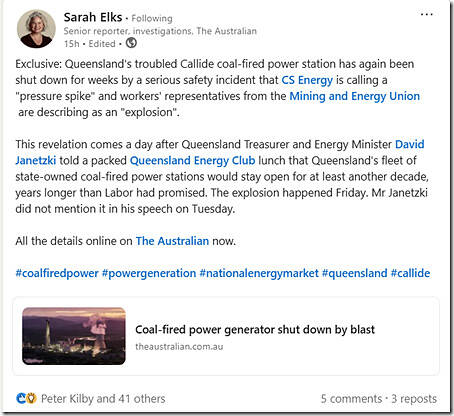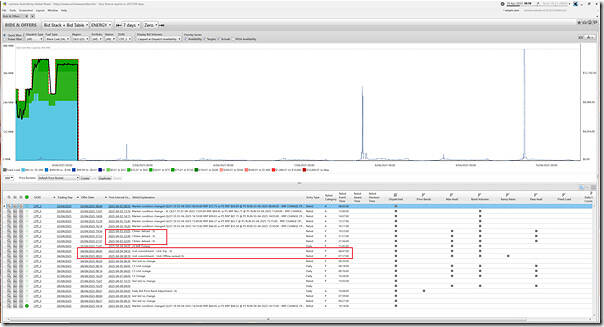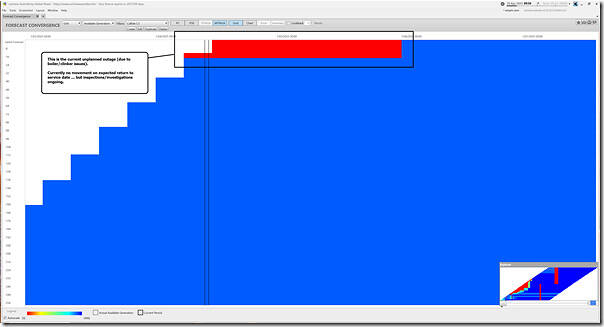Yesterday I briefly noted ‘A few stories in (coal) generator outages (at Wednesday 9th April 2025)’ after noticing a few different things in the week-or-so prior to that time.
A bit of history
Before we start, and for those not following as closely, some history:
1) Callide C is a supercritical coal-fired station that’s a newer addition to what had been Callide A (since closed) and Callide B stations in central Queensland – near Biloela.
(a) whilst Callide A and Callide B were fully owned by the Queensland Government (via CS Energy) …
(b) Callide C had been developed as a public-private partnership in the early days of the NEM:
i. between CS Energy and IG Power (the ownership structure of which is complex and has changed over time, with Intergen and Genuity involved – and hence Sev.En)
ii. traded in the market via Callide Power Trading
(c) With reference to the same government policy (i.e. that new units must be built by public-private partnerships, in part to demonstrate to the government that there was a real market need):
i. Tarong North had been developed by Tarong Energy under the same remit … though in that case the private sector investor (TEPCO) had sold out of their share some time later.
ii. Kogan Creek was initially developed with that in mind, but proceeded later. Specifics lost in the dims of my memory.
iii. The old Stanwell Corporation, the 3rd corporation with assets (not forgetting Enertrade was a bit different as the 4th) did not get a project up under the same policy.
2) Callide C is a 2- unit station:
(a) It was the sibling unit Callide C4 that experienced the ’Callide C4 catastrophe’ on 25th May 2021 that meant it was offline for 1193 days in total … we provided plenty of articles about that.
(b) Whilst the unit in question (Callide C3) also experienced a long outage (518 days) due to Cooling Tower failure.
3) This ‘A selected (and evolving) chronology of the QLD Government’s involvement in the QLD Generation sector’ from 2017 might be useful.
Fast forward to the current day:
In the Minister’s address at Queensland Energy Club this week there were comments about all 4 Callide units (i.e. B1 & B2 and C3 & C4).
… but it’s important to understand what comment referred to which station!
In this article we’re going to focus on Callide C3, which came offline on Friday 4th April 2025 in an outage that currently looks set to last until Friday 30th May 2025.
1) This was noted in the snapshot from ‘Generator Outages’ widget in ez2view that we published yesterday morning
2) The other important piece of information there was that was that the Unit State showed up as an ‘Unplanned Forced Outage’ in the bid data submitted by the generator.
3) That’s a forced outage duration of 56 days … which (whilst it is not unheard of, obviously) is also not the norm, and so notable.
I had in mind that this was one of the ‘coal outage’ stories I’d write about when I posted the above yesterday, but was prompted to invest a bit of time today because of a few social media updates – such as this one from Sarah Elks from the Australian:
… and others (like this one from the former Energy Minister Mark Bailey) that all point to Sarah’s article ‘Callide coal-fired power station shut down again’ published on Wednesday 9th April 2025 in the Australian which contains some interesting comments (for those who can access).
In terms of what we can point to and reference:
(A) Elsewhere
Flipping through a few different information sources we have access to, we see
A1) What’s noted by CS Energy
Noting above that Callide C is only 50% owned by CS Energy (though it is maintained by CS Energy as part of the arrangement) we can check the CS Energy news page and see two updates recently:
(a) On Wednesday 9th April 2025 the company posted ‘Callide C3 offline for repairs’ … which is worth copying in here in full:
‘Unit C3 at Callide Power Station is currently offline for repairs until 30 May following an incident on the unit last Friday.
On 4 April, a significant clinker (hardened ash) detached from the internal boiler wall of Unit C3.
Clinker formation is common in coal-fired power stations. CS Energy has clinker management tools and practices in place to regularly detach clinkers from furnace tubes so they can fall to the bottom of the boiler for easy removal.
On this occasion, when the clinker detached, it resulted in a pressure spike within the furnace. Our initial assessment is that repairs are required to cladding and lagging on the upper section of the boiler.
No one was in the area at the time of the event and there were no injuries. The unit’s protection systems worked as design to shut down the unit.
CS Energy notified Workplace Health and Safety Queensland (WHSQ) on the day of the incident. Yesterday WHSQ approved for CS Energy to access the area.
Investigations and inspections are ongoing to fully assess what occurred and the repairs required to safely return the unit to service. Access is restricted to key personnel only.
Across all CS Energy power stations, we have strengthened clinker controls and are continuing proactive clinker deloads as guided by management tools. Access is also being restricted in boiler areas while clinker deloads are carried out.
Callide Power Station’s other three generating units, as well as Kogan Creek Power Station, are all online and available to support Queensland’s energy needs.
Background
Clinker deloads are common practice in the management of clinkers at coal-fired power stations. By reducing the load, it reduces the pressure inside the boiler, allowing the clinker to detach from the side and fall to the bottom of the boiler for easy removal.
Callide Power Station is comprised of two power plants, Callide B and C, each with two generating units (B1 and B2, C3 and C4).
Callide B has a capacity of 700 megawatts (MW) and is 100 per cent owned by CS Energy.
Callide C has a capacity of 848 MW. CS Energy (through our subsidiary Callide Energy Pty Ltd) owns Callide C in a 50/50 joint venture (JV) with IG Power. CS Energy operates Callide C on behalf of the JV.’
(b) As an unfortunate coincidence, the day prior there was an article about the ‘Resignation of Chief Executive Officer’ (Darren Busine).
A2) Nothing noted by the other joint venture party (parties)
There’s nothing noted on the Genuity website … and I also did not see anything on the Sev.En Media Page.
A3) Other media?
Other media articles we’ve noted include:
1) Today in RenewEconomy Giles Parkinson wrote ‘Coal plant shut down by “blast” days before Queensland LNP reveals life extension for fossil fuel generators’
… though in case readers misread the headline, it was Callide B life extension that David Janetzki was talking about, not Callide C.
2) Today in Energy Source & Distribution is ‘Clinker incident takes out Callide Unit C3 in Queensland’.
3) In IQ Industry News there is this note
(B) Within the market data
Utilising a couple widgets in our ez2view software, we take a quick look at what’s visible here…
B1) In the daily bid data
Utilising the ‘Bids & Offers’ widget, here’s a concatenated view of all of the bids for the CPP_3 unit over the past 7 days (i.e. to 04:00 this morning, when we rolled into the current market day where bids are currently confidential):
We can see:
1) Some rebids on Thursday 3rd April referencing the clinker de-load process
… as noted in the CS Energy update above, clinker something that forms in most coal boilers (at a rate depending on specific coal quality parameters), and removal of the clinker is a standard process (which appears to have gone awry in this case).
2) On Friday morning 4th April 2025 we see a rebid at 04:45 (NEM time) referencing the unit trip.
Obviously the absence of a large coal unit in QLD was one factor (of many) that contributed to evening volatility this week – on Monday 7th April, Tuesday 8th April and Wednesday 9th April (with the price trace also shown on the bid stack chart above).
B2) Comparing successive (updated) outage plans
We’re continuing to be grateful to the relevant people who proposed (and passed) the ERM Rule Change in providing additional transparency of the
… though we’re also continuing to be mystified by what seems to be short-sightedness in not including the physical plant availability of Semi-Scheduled units in that remit for enhanced transparency (do they not also have a need for planned outages, or experienced forced outages?).
This will again come in handy, because we read in the CS Energy update above that:
‘Investigations and inclinkerspections are ongoing to fully assess what occurred and the repairs required to safely return the unit to service. Access is restricted to key personnel only.’
… which I take to mean that the initial (guesstimate) return to service date may be likely to change, once a full condition of the plant is assessed.
For our growing number of ez2view licensed users, they can utilise the ‘Forecast Convergence’ widget to make it easy to keep track of successive changes in return to service expectations. Here’s an initial view this morning at 09:50 (NEM time) with the view filtered to CPP_3 unit and zoomed out to show the full ~6 year time horizon:
Remember this widget allows one to ‘look up a vertical’ in order to ‘see that other dimension of time’.
Zooming in right at the top, we see this:
So for those clients with a licence, you can keep an eye out there (or in other widgets).






On this occasion, when the clinker detached, it resulted in a pressure spike within the furnace. Our initial assessment is that repairs are required to cladding and lagging on the upper section of the boiler.
Pressures spike?
Is this technical writer gibberish for tube leak?
Was it a furnace loss of ignition?
On this occasion, when the clinker detached, it resulted in the release of steam from the ash conveyor water system. The released steam extinguished the flames of all four fuel pulverisers (mills), prompting an automatic unit trip, in accordance with the unit’s safety design.
Is this more technical writer ignorance, and another CS Energy coverup?
Was it caused by oil torch ignition by the unit operator after the loss of the PF mills?